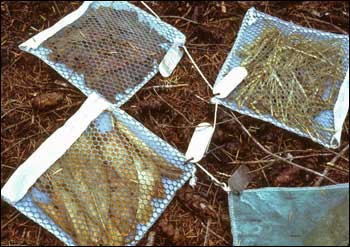Some of the greatest uncertainties about how the Earth will respond to global warming are becoming more certain, thanks to the work of scientists such asSteve Hart, a forestry professor and researcher at Northern Arizona University.
“One uncertainty has been the complex suite of feedbacks that may occur between the atmosphere and the biosphere,” said Hart, who was part of a decade-long study of decomposing leaves and roots left in 21 field sites in North and Central America.
Hart co-authored the Long-Term Inter-site Decomposition Experiment and is part of the original team whose “plant litter” (dead plant tissue) work was featured in the January 19 issue of the journal Science.
Results of the study are offering scientists a way to predict the accuracy of global change models by better predicting nitrogen availability to plants. It reveals a simple pattern that can predict large-scale patterns in nitrogen release from plant litter.
“Our results are important because one of the weakest parts of global change models is predicting how terrestrial areas will respond to climatic changes,” Hart said. “Now we have scientific evidence that, for soil microorganisms, there is a fundamental physiological constraint controlling nitrogen release from plant litter during decomposition. This constraint is valid regardless of climate and soil conditions where decomposition occurs.”
Hart explained that higher concentrations of carbon dioxide in the atmosphere, the main driver of global warming, may lead to increased rates of carbon dioxide uptake by plants (resulting in higher rates of plant growth) that could slow the rate that the Earth heats up.
“Increased plant growth will only occur if other key growth requirements, like available nitrogen, are also supplied at higher rates,” Hart said. “Only two variables are needed to determine the rate at which nitrogen is released from plant litter: The first is how much nitrogen was in the litter to begin with, and the second is how far the litter had gone through its decay cycle.”
More than three-fourths of the air is nitrogen gas, but most plants are unable to use this form of nitrogen and must rely on the release of nitrogen contained in plant remains during decay of this material by soil bacteria and fungi.
Hart noted that nitrogen generally is the most limiting nutrient for plant growth globally because this source of available nitrogen is limited and plants have a high nitrogen requirement for growth.
The plant litter decomposition project involved 21 field sites representing seven types of climatic conditions (biomes) from Arctic tundra to Central American tropical forests. Each mesh bag, containing a specific type of leaf or root litter, representing a wide range of chemical compositions from tropical hardwoods to common wheat, sat exposed to the elements, day and night, throughout the four seasons, gradually rotting away for a decade.
Co-authors of the study include researchers from Colorado State University, the University of California at Berkeley, Oregon State University, the University of Michigan, and the University of Minnesota.
Hart, who helped initiate the study while he was a post-doctoral researcher at Oregon State University just before coming to NAU, said the only exception for the model is arid grasslands where the decomposition process is affected by extreme exposure to ultraviolet radiation.
Soon after his 1991 arrival at NAU, Hart initiated a similar decomposition study using ponderosa pine needles at the Gus Pearson Natural Area, near Flagstaff.
He recently retrieved the final litter bags from that study, where needle litter had been decomposing for 12 years, and much of the remaining material was still identifiable as pine needles.
“It will be interesting to see if nitrogen release from ponderosa pine needles in the arid Southwest will fit the global model,” Hart said.



